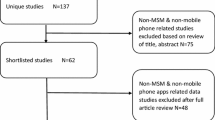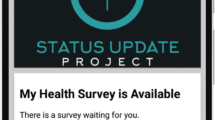Abstract
This study is the first published multi-app study, of which we are aware, to evaluate both the acceptability and feasibility of providing sexual health information and HIV/STD testing referrals via established geosocial and sexual networking apps for MSM. Data were collected using an online survey and through four apps (A4A Radar, Grindr, Jack’d, and Scruff). Two-thirds (64 %) found apps to be an acceptable source for sexual health information. MSM who found apps as acceptable were more likely non-white, not sure of their current HIV status, and have low HIV testing self-efficacy. One-quarter (26 %) of informational chats with the health educator resulted in users requesting and being referred to local HIV/STD testing sites. There were significant differences in the number and types of interactions across apps. Established apps designed for MSM may be both an acceptable and feasible platform to promote HIV/STD testing. Future research should evaluate interventions that leverage this technology.
Resumen
Este es el primer estudio publicado sobre aplicaciones múltiples que conocemos, realizado para evaluar la aceptabilidad y la viabilidad de proporcionar información de salud sexual y derivaciones para pruebas de VIH/ETS por medio de aplicaciones geosociales diseñadas para conexiones sociales y sexuales para HSH (hombres que tienen sexo con hombres). La información fue recopilada por medio de una encuesta en línea, y a través de cuatro aplicaciones (A4A Radar, Grindr, Jack’d, y Scruff). Dos tercios (64 %) de los encuestados respondieron que las aplicaciones eran una fuente aceptable para proveer información de salud sexual. Los HSH que encontraron las aplicaciones aceptables fueron principalmente hombres que no eran de raza blanca quienes no estaban seguros de su seropositividad, y cuyas pruebas de VIH son irregulares. Una cuarta parte (26 %) de las charlas informativas con el educador de salud dieron lugar a que los usuarios solicitaran y fueran referidos a sitios de pruebas de detección del VIH/ETS en su localidad. Hubo diferencias significativas en el número y tipos de interacciones dependiendo de las aplicaciones usadas. Las aplicaciones para HSH pueden ser una plataforma aceptable y viable para promover pruebas de VIH/ETS. Investigación futura debe evaluar intervenciones que aprovechen esta tecnología.
Similar content being viewed by others
References
Purcell DW, Johnson CH, Lansky A, et al. Estimating the population size of men who have sex with men in the United States to obtain HIV and syphilis rates. Open AIDS J. 2012;6(Suppl 1:M6):98–107.
Centers for Disease Control and Prevention. Estimated HIV incidence in the United States, 2007–2010. HIV Surveillance Supplemental Report 2012;17(No. 4).
Hall HI, Song R, Rhodes P, et al. Estimation of HIV incidence in the United States. JAMA. 2008;300(5):520–9.
Census Bureau. Annual estimates of the resident population for the United States, regions, states, and Puerto Rico. Available at: http://www.census.gov/popest/data/state/totals/2011/. Accessed April 15, 2014.
Centers for Disease Control and Prevention. HIV Surveillance Report, 2011; vol. 23. http://www.cdc.gov/hiv/topics/surveillance/resources/reports/. Published February 2013. Accessed March 3, 2014.
Hanna DB, Selik RM, Tang T, Gange SJ. Disparities among US states in HIV-related mortality in persons with HIV infection, 2001–2007. AIDS. 2012;26(1):95–103.
North Carolina Department of Health and Human Services. Epidemiologic profile for HIV/STD prevention & care planning. Raleigh, NC; 2012.
Free C, Phillips G, Galli L, et al. The effectiveness of mobile-health technology-based health behaviour change or disease management interventions for health care consumers: a systematic review. PLoS Med. 2013;10(1):1–45.
Lim MSC, Hocking JS, Aitken CK, et al. Impact of text and email messaging on the sexual health of young people: a randomised controlled trial. J Epidemiol Community Health. 2012;66(1):69–74.
Lester RT, Ritvo P, Mills EJ, et al. Effects of a mobile phone short message service on antiretroviral treatment adherence in Kenya (WelTel Kenya1): a randomised trial. Lancet. 2010;376(9755):1838–45.
Bourne C, Knight V, Guy R, Wand H, Lu H, McNulty A. Short message service reminder intervention doubles sexually transmitted infection/HIV re-testing rates among men who have sex with men. Sex Transm Infect. 2011;87(3):229–31.
Gold J, Aitken CK, Dixon HG, et al. A randomised controlled trial using mobile advertising to promote safer sex and sun safety to young people. Health Educ Res. 2011;26(5):782–94.
Rhodes SD, Vissman AT, Stowers J, et al. A CBPR partnership increases HIV testing among men who have sex with men (MSM): outcome findings from a pilot test of the CyBER/testing internet intervention. Health Educ Behav. 2011;38(3):311–20.
Reback CJ, Grant DL, Fletcher JB, et al. Text messaging reduces HIV risk behaviors among methamphetamine-using men who have sex with men. AIDS Behav. 2012;16(7):1993–2002.
Odeny TA, Bailey RC, Bukusi EA, et al. Text messaging to improve attendance at post-operative clinic visits after adult male circumcision for HIV prevention: a randomized controlled trial. PLoS ONE. 2012;7(9):e43832.
Noar SM, Willoughby JF. eHealth interventions for HIV prevention. AIDS Care. 2012;24(8):945–52.
Lim MSC, Hocking JS, Hellard ME, Aitken CK. SMS STI: A review of the uses of mobile phone text messaging in sexual health. Int J STD AIDS. 2008;19(5):287–90.
Swendeman D, Rotheram-Borus MJ. Innovation in sexually transmitted disease and HIV prevention: internet and mobile phone delivery vehicles for global diffusion. Curr Opin Psychiatry. 2010;23(2):139–44.
Bull SS, Walker T, Levine D. Communities and technology: enhancements in HIV prevention research and practice among adolescents and young adults. In: Rhodes SD, editor. Innovations in HIV prevention research and practice through community engagement. New York: Springer; 2014.
Nielsen. State of the media: the social media report; 2012. p. 1–28.
148apps.biz. Count of Active Applications in the App Store. Available at: http://148apps.biz/app-store-metrics/. Accessed March 20, 2014.
Appling G, Pappalardo G. The rise of mobile application stores: gateways to the world of apps; 2010. p. 1–18.
Muessig KE, Pike EC, Legrand S, Hightow-Weidman LB. Mobile phone applications for the care and prevention of HIV and other sexually transmitted diseases: a review. J Med Internet Res. 2013;15(1):e1.
Grosskopf NA, Levasseur MT, Glaser DB. Use of the internet and mobile-based “apps” for sex-seeking among men who have sex with men in New York City. Am J Mens Health. 2014;8(6):510–20; epub ahead of print.
Ross MW, Tikkanen R, Månsson SA. Differences between Internet samples and conventional samples of men who have sex with men: implications for research and HIV interventions. Soc Sci Med. 2000;51(5):749–58.
Elford J, Bolding G, Davis M, Sherr L, Hart G. Web-based behavioral surveillance among men who have sex with men: a comparison of online and offline samples in London, UK. J Acquir Immune Defic Syndr. 2004;35(4):421–6.
Flores SA, Bakeman R, Millett GA, Peterson JL. HIV risk among bisexually and homosexually active racially diverse young men. Sex Transm Dis. 2009;36(5):325–9.
Landovitz RJ, Tseng C-H, Weissman M, et al. Epidemiology, sexual risk behavior, and HIV prevention practices of men who have sex with men using GRINDR in Los Angeles, California. J Urban Heal. 2013;90(4):729–39.
Rendina HJ, Jimenez RH, Grov C, Ventuneac A, Parsons JT. Patterns of lifetime and recent HIV testing among men who have sex with men in New York City who use Grindr. AIDS Behav. 2014;18(1):41–9.
Vial AC, Starks TJ, Parsons JT. Finding and recruiting the highest risk HIV-negative men who have sex with men. AIDS Educ Prev. 2014;26(1):56–67.
Hemmelgarn S. Grindr now STD outreach tool. Bay Area Report. 2014;44(17):1–5.
The Social Science Research Lab. Lessons learned in the field—Vista Community Clinic’s online HIV prevention activities: 2008–2012; 2013. p. 1–39.
Oregon HIV/Viral Hepatitis/Sexually Transmitted Infection Integrated Planning Group. Oregon’s jurisdictional HIV prevention plan; 2012. p. 1–46.
China-Gates Foundation HIV Prevention Cooperation Program. A new HIV/AIDS intervention model for MSM: experience of using social media for AIDS interventions and HIV testing; 2013. p. 1–50.
Rhodes SD, Mann L, Alonzo J, et al. CBPR to prevent HIV within ethnic, sexual, and gender minority communities: successes with long-term sustainability. In: Rhodes SD, editor. Innovations in HIV prevention research and practice through community engagement. New York: Springer; 2014.
Rhodes SD, Bowie DA, Hergenrather KC. Collecting behavioural data using the world wide web: considerations for researchers. J Epidemiol Community Health. 2003;57(1):68–73.
Rhodes SD, Hergenrather KC, Yee LJ, Ramsey B. Comparing MSM in the southeastern United States who participated in an HIV prevention chat room-based outreach intervention and those who did not: how different are the baseline HIV-risk profiles? Health Educ Res. 2008;23(1):180–90.
Rhodes SD, Hergenrather KC, Duncan J, et al. A pilot intervention utilizing Internet chat rooms to prevent HIV risk behaviors among men who have sex with men. Public Health Rep. 2010;125(Suppl 1):29–37.
Rhodes SD, Hergenrather KC, Yee LJ, Knipper E, Wilkin AM, Omli MR. Characteristics of a sample of men who have sex with men, recruited from gay bars and Internet chat rooms, who report methamphetamine use. AIDS Patient Care STDS. 2007;21(8):575–83.
Rhodes SD, DiClemente RJ, Cecil H, Hergenrather KC, Yee LJ. Risk among men who have sex with men in the United States: a comparison of an Internet sample and a conventional outreach sample. AIDS Educ Prev. 2002;14(1):41–50.
O’Brien MC, McCoy TP, Champion H, et al. Single question about drunkenness to detect college students at risk for injury. Acad Emerg Med. 2006;13(6):629–36.
Rhodes SD, McCoy TP, Hergenrather KC, et al. Prevalence estimates of health risk behaviors of immigrant Latino men who have sex with men. J Rural Health. 2012;28(1):73–83.
Hosmer DW, Lemeshow S. Applied logistic regression. New York: Wiley; 1989.
Centers for Disease Control and Prevention. Revised recommendations for HIV testing of adults, adolescents, and pregnant women in health-care settings. MMWR. 2006;55(RR14):1–17.
Horvath KJ, Rosser BRS, Remafedi G. Sexual risk taking among young internet-using men who have sex with men. Am J Public Health. 2008;98(6):1059–67.
Centers for Disease Control and Prevention. HIV testing and risk behaviors among gay, bisexual, and other men who have sex with men—United States. MMWR. 2013;62(47):958–62.
Plankey MW, Ostrow DG, Stall R, et al. The relationship between methamphetamine and popper use and risk of HIV seroconversion in the multicenter AIDS cohort study. J Acquir Immune Defic Syndr. 2007;45(1):85–92.
Hartfield LA, Horvath KJ, Jacoby SM, Rosser BRS. Comparison of substance use and risky sexual behavior among a diverse sample of urban, HIV-positive men who have sex with men. J Addict Dis. 2007;28(3):208–18.
Colfax G. Substance Use and Sexual Risk: a participant- and episode-level analysis among a cohort of men who have sex with men. Am J Epidemiol. 2004;159(10):1002–12.
Stall R, Purcell DW. Intertwining epidemics: a review of research on substance use among men who have sex with men and its connection to the AIDS epidemic. AIDS Behav. 2000;4(2):181–92.
Holloway IW, Rice E, Gibbs J, Winetrobe H, Dunlap S, Rhoades H. Acceptability of smartphone application-based HIV prevention among young men who have sex with men. AIDS Behav. 2014;18(2):285–96.
Acknowledgments
We would like to sincerely thank the study participants for their time and openness and Addison Ore for her support and insights. This material is based upon support from the National Institutes of Health (R01MH092932; PI: Scott D. Rhodes).
Author information
Authors and Affiliations
Corresponding author
Rights and permissions
About this article
Cite this article
Sun, C.J., Stowers, J., Miller, C. et al. Acceptability and Feasibility of Using Established Geosocial and Sexual Networking Mobile Applications to Promote HIV and STD Testing Among Men Who Have Sex with Men. AIDS Behav 19, 543–552 (2015). https://doi.org/10.1007/s10461-014-0942-5
Published:
Issue Date:
DOI: https://doi.org/10.1007/s10461-014-0942-5




